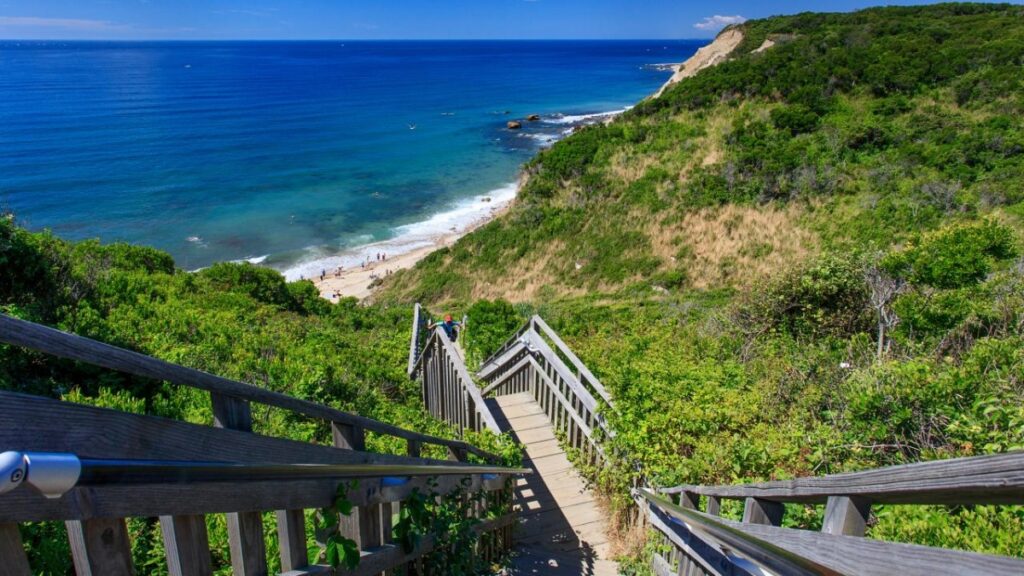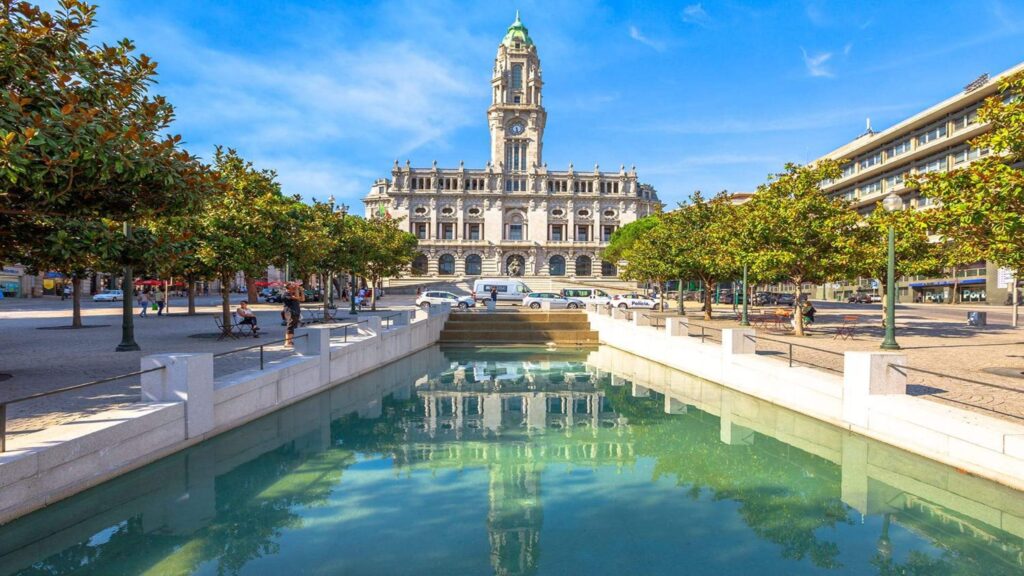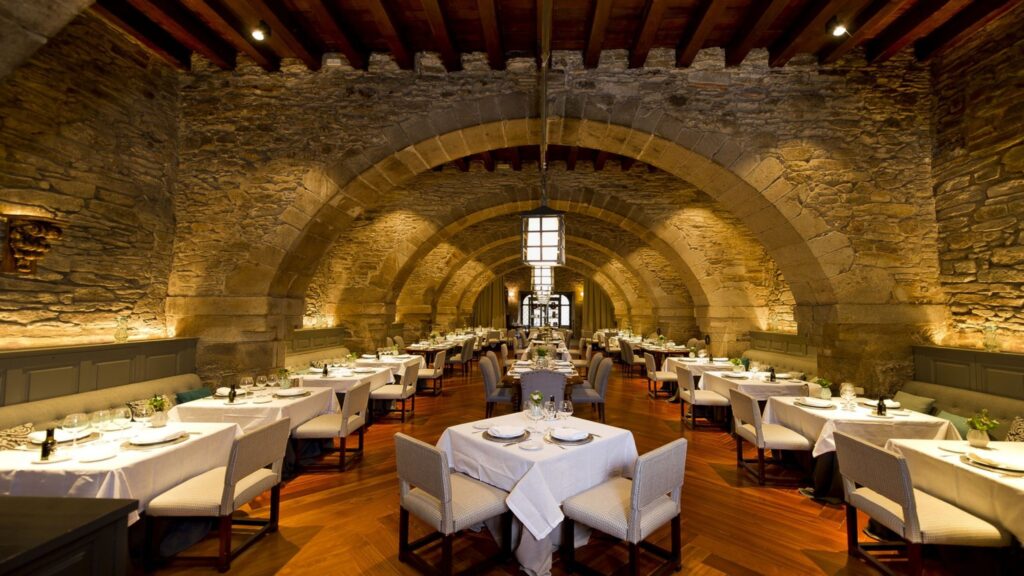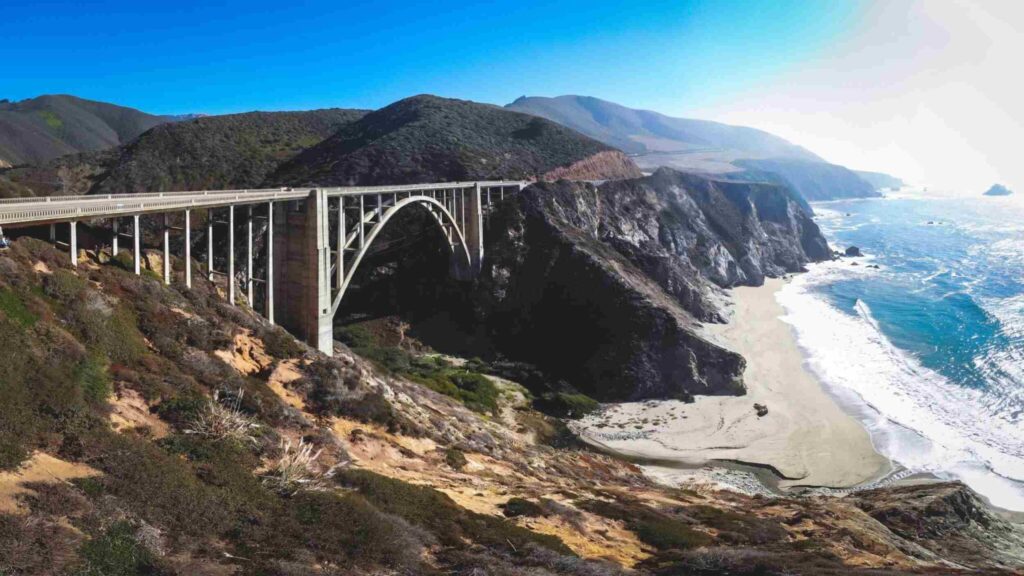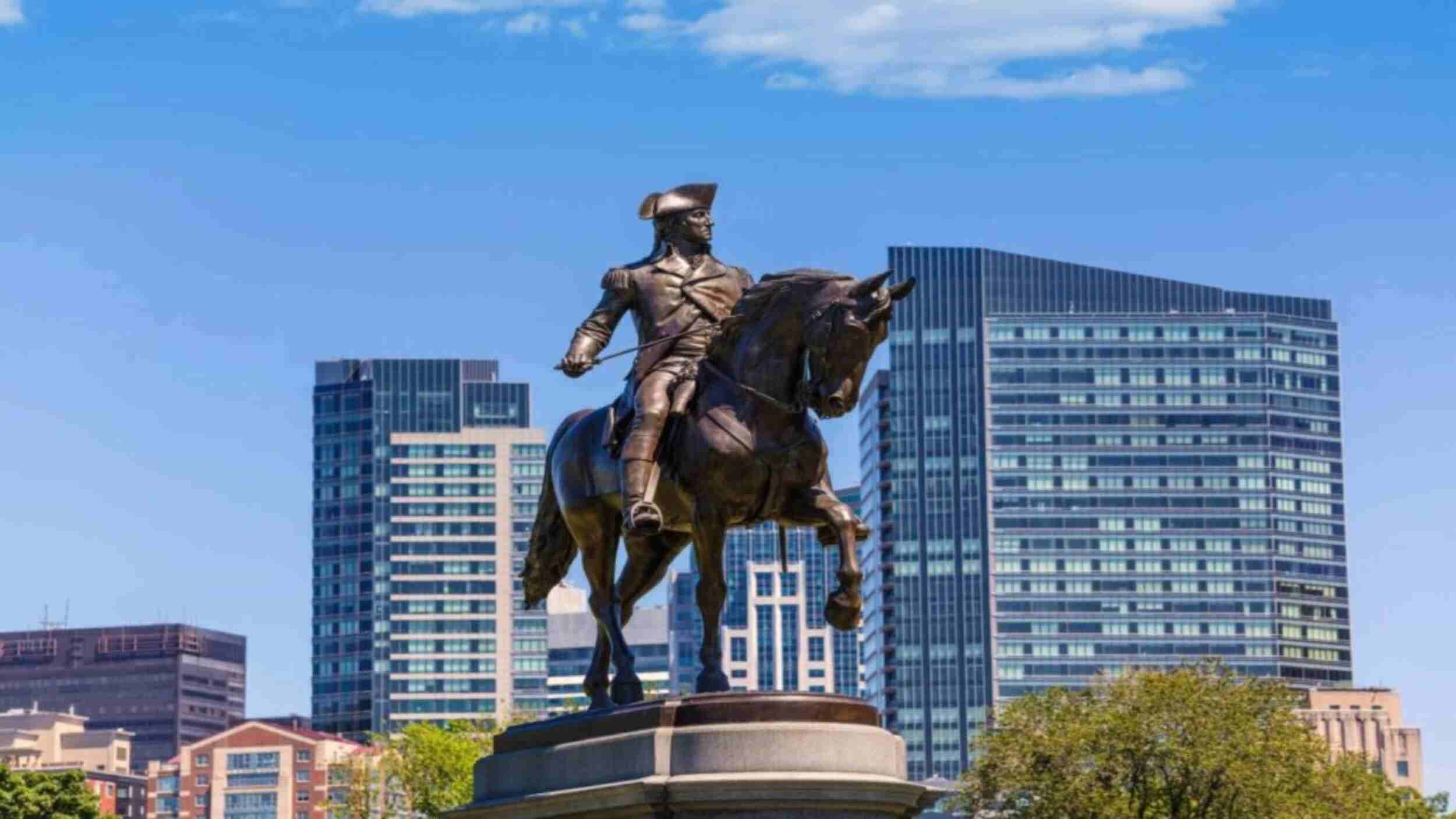
I’ve explored these Freedom Trail Boston stops dozens of times. Each visit reveals something new about America’s revolutionary heritage. Therefore, this freedom trail starting point offers an immersive journey through centuries of history. Additionally, it transformed a colonial settlement into the birthplace of American liberty.
My countless walks along this famous path taught me perfect timing for each landmark. The entire route connects sites where America’s founding fathers debated and planned their independence. Instead of following crowded tour groups, I recommend taking your time. However, absorbing the profound significance of where you stand at each stop makes all the difference.
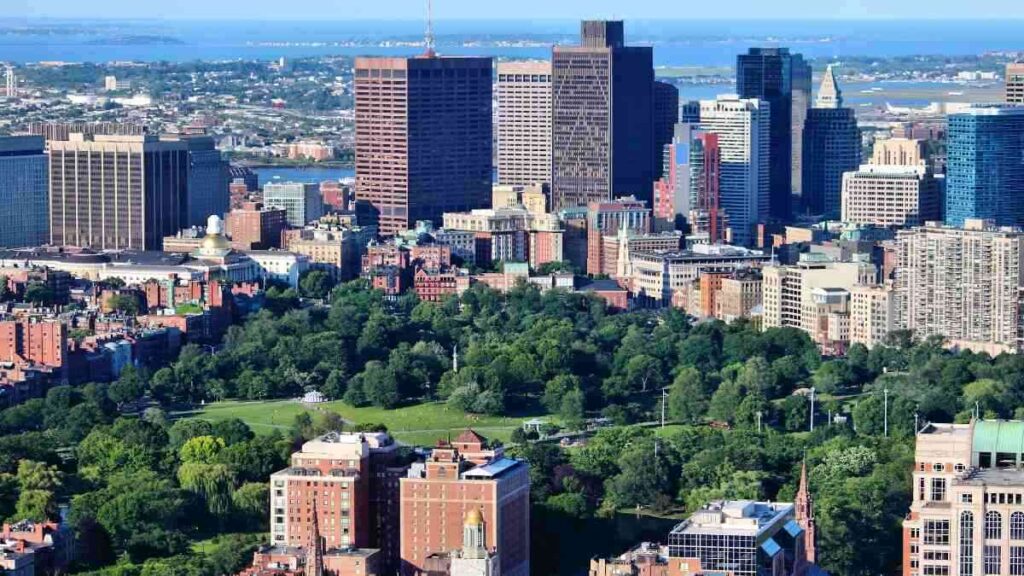
Starting Your Freedom Trail Boston Stops Adventure
Boston Common provides the ideal starting point for your historic journey through America’s revolutionary past. This 50-acre green space witnessed everything from colonial protests to modern celebrations. Therefore, early morning visits between 7:30 and 8:30 am offer the most peaceful experience. Also, tourist crowds arrive later at this freedom trail location where to start freedom trail adventures.
Boston Common Navigation Tips
The distinctive red brick path begins at the Boston Common visitor centre. Helpful staff provide maps and historical context for your journey. In the spring months, cherry blossoms provide a beautiful and vivid backdrop. In autumn, vibrant foliage creates a striking frame for your first glimpses of revolutionary history.
Modern amenities blend seamlessly with historical preservation throughout the Boston Common area. Public restrooms and food vendors offer convenience for visitors. Yet the atmosphere remains respectfully focused on the site’s tremendous historical significance. However, I recommend independent exploration to discover personal connections with revolutionary history at your own pace.
Massachusetts State House Visit
Just beyond Boston Common stands the magnificent Massachusetts State House. Its iconic golden dome gleams brilliantly in sunlight. The building’s neoclassical architecture symbolizes the democratic ideals that grew out of the Revolutionary struggle. As a result, guided tours run on weekdays between 10 a.m. and 3:30 p.m.
The dome originally was constructed from wood and covered in copper by Paul Revere himself. It received its gold leafing in 1874 for enhanced beauty. However, the building’s true significance lies in its role as Massachusetts government seat since 1798. Thus, historical exhibits inside showcase the transition from colonial rule to democratic governance.
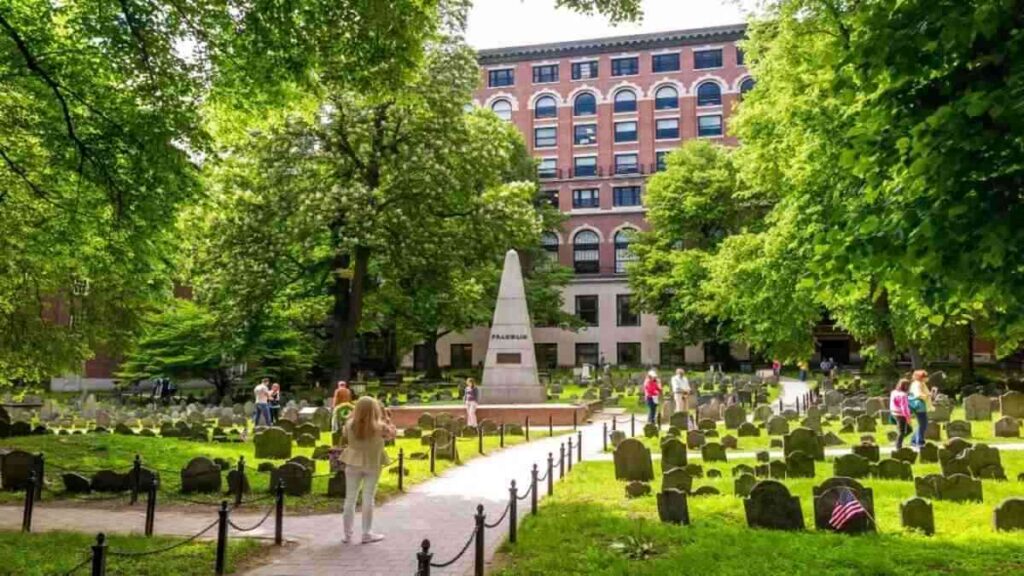
Sacred Sites That Shaped Revolutionary History
Ancient burial grounds along this route contain remains of revolutionary heroes. Their sacrifices secured American independence for future generations. Particularly, afternoon visits between 1 pm and 4 pm provide optimal lighting for reading weathered inscriptions. Furthermore, maintaining appropriate reverence for these hallowed grounds shows respect for fallen patriots.
Historic Burial Grounds
The Granary Burying Ground holds particular significance as the final resting place. Three signers of the Declaration of Independence rest here. Established in 1660, this cemetery witnessed the transformation from colonial settlement to revolutionary birthplace. Therefore, walking amongst these graves reveals ordinary citizens who became extraordinary patriots.
Weathered headstones tell stories of families torn apart by war. Individuals risked everything for future generations of Americans. The elaborate carved symbols and Latin inscriptions reflect Puritan beliefs about mortality. Yet each grave represents someone who chose to resist tyranny. Moreover, resistance meant potential death for treason against the crown.
Stone carvings have survived harsh New England winters for centuries. They offer a concrete link between the past and the present. These artistic elements demonstrate colonial craftsmanship beautifully. In fact, they serve as permanent memorials to revolutionary sacrifice.
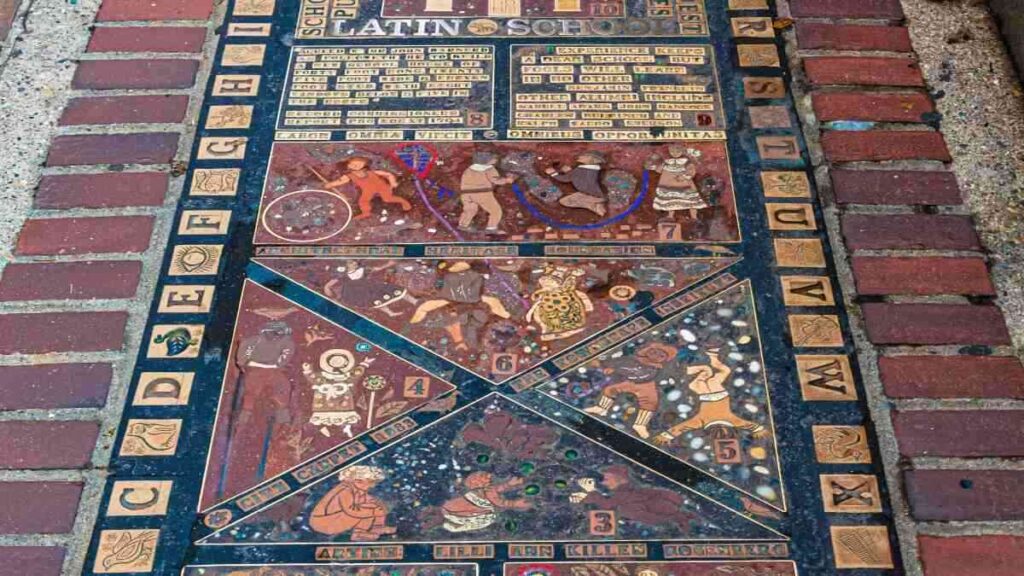
Freedom Trail Boston Stops: Educational Sites Worth Exploring
Educational institutions along this route shaped the intellectual foundation that made American revolution possible. Boston Latin School, founded in 1635, educated future leaders including Benjamin Franklin. These schools helped people think more clearly and learn important subjects. They gave colonists the thinking skills they needed to explain ideas about democracy.
America’s Oldest School
The original Boston Latin School building no longer exists today. However, a bronze plaque marks the site where America’s oldest public school once stood. This institution produced five signers of the Declaration of Independence. Certainly, it educated four Harvard University presidents who shaped American intellectual development.
Classical education emphasised rhetoric, logic, and philosophy that proved essential for revolutionary leaders. Students studied ancient Greek and Roman republics carefully. They discovered precedents for democratic governance that challenged monarchical rule. Obviously, the school’s influence extended far beyond Boston into American educational philosophy.
Modern Boston Latin School continues this educational tradition in a different location. It maintains academic excellence that produces leaders across multiple generations. The connection between education and democratic participation remains as relevant today. Especially, visiting this historic site reminds us that intellectual freedom must precede political freedom.
Faneuil Hall Marketplace
Revolutionary meetings happened at Faneuil Hall, known as the “Cradle of Liberty”. Colonial leaders planned resistance against British taxation here. This building had two uses: it was both a marketplace and a meeting hall. For example, it reflected the connection between economic and political freedom perfectly.
The building’s architecture combines practical commerce with civic engagement beautifully. Market stalls on the ground floor funded the building’s construction and maintenance. They provided space for public gatherings above the commercial area. Indeed, this innovative design reflects American pragmatism that combines idealism with practical solutions.
Today’s Quincy Market continues the tradition of commerce and civic engagement. Modern food courts have replaced colonial merchants throughout the building. The bustling atmosphere still echoes revolutionary energy when ordinary citizens gathered. Similarly, standing in this historic space allows you to hear passionate voices that launched independence.
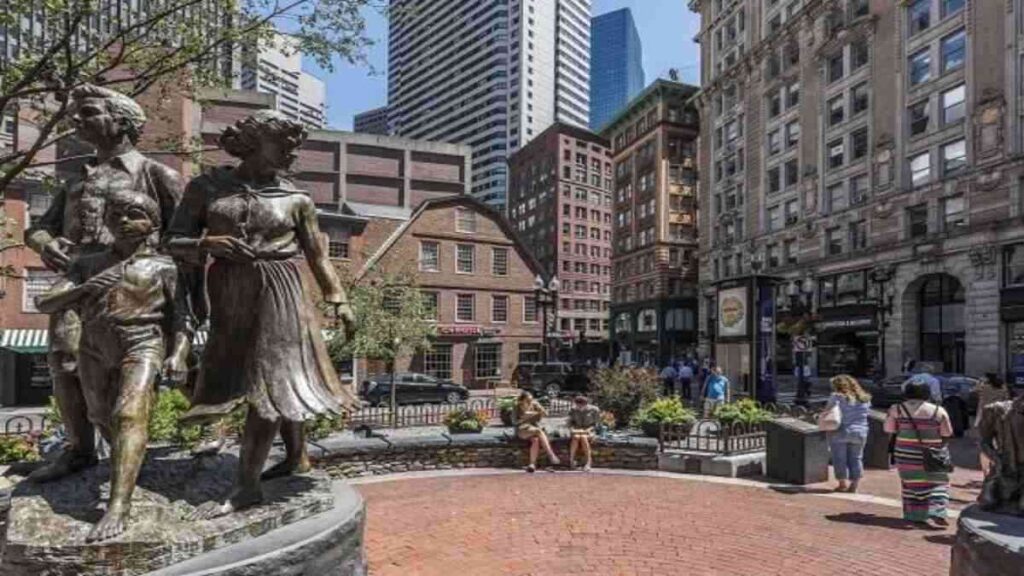
Cultural Heritage Discovery Beyond Boston’s Historic Trail
Literary traditions flourished in revolutionary Boston, establishing the city as America’s intellectual capital. Writers, publishers, and philosophers gathered in coffee houses and bookshops. They debated ideas that would reshape Western civilisation completely. Because of this, these cultural institutions provided safe spaces for revolutionary thinking when political dissent was dangerous.
Freedom Trail Boston Stops: Literary Heritage
The Old Corner Bookstore served as headquarters for American literary renaissance. It printed books by Henry David Thoreau, Nathaniel Hawthorne, and Ralph Waldo Emerson. This small building was where American writing began. As a result, publishers here recognised that cultural independence must accompany political independence for true national identity.
Intellectual salons brought together writers, politicians, and merchants who shared ideas. These gatherings created the philosophical foundation for American democracy. They fostered artistic expression that reflected revolutionary ideals beautifully. Due to this, the cross-pollination between politics and culture produced uniquely American perspectives on liberty and equality.
Modern visitors can still sense the intellectual energy that once filled these spaces. Ideas transformed societies in these very rooms. The building now houses different businesses throughout its historic walls. So that, reading rooms and libraries throughout Boston continue this tradition of intellectual exchange.
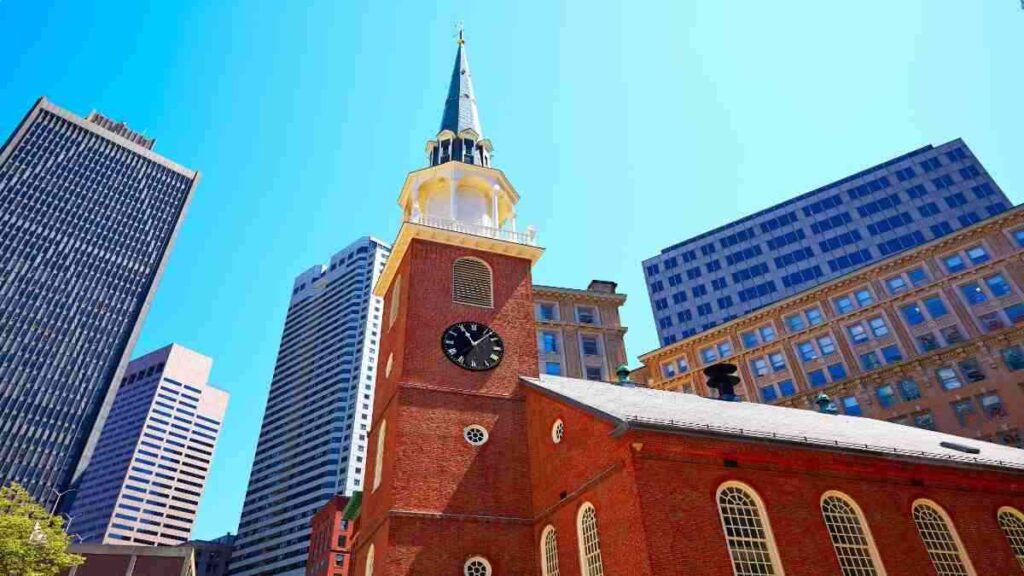
Revolutionary Landmarks That Changed American History
Political resistance crystallised at specific locations where colonists made irreversible decisions. These sites witnessed the transformation from peaceful protest to armed rebellion. Diplomatic solutions proved impossible for resolving colonial grievances. Therefore, each landmark represents a moment when ordinary people chose extraordinary courage.
Historic Meeting Houses
The Old South Meeting House hosted the Boston Tea Party planning sessions. Colonists chose to throw British tea into Boston Harbor here. This church building provided neutral ground where religious and political leaders gathered. Next, the large meeting hall accommodated thousands of colonists who participated in democratic decision-making.
Acoustic design allowed speakers to address large crowds without amplification technology. It created an intimate connection between leaders and citizens. The building’s religious purpose provided moral legitimacy for political resistance. Later, it offered sanctuary from British surveillance during dangerous times.
Standing in this historic space today, you can imagine the tension. Colonists debated whether to proceed with actions that could trigger armed conflict. The weight of their decision reverberates through American history. Finally, modern Americans inherit both the benefits and responsibilities of decisions made here.
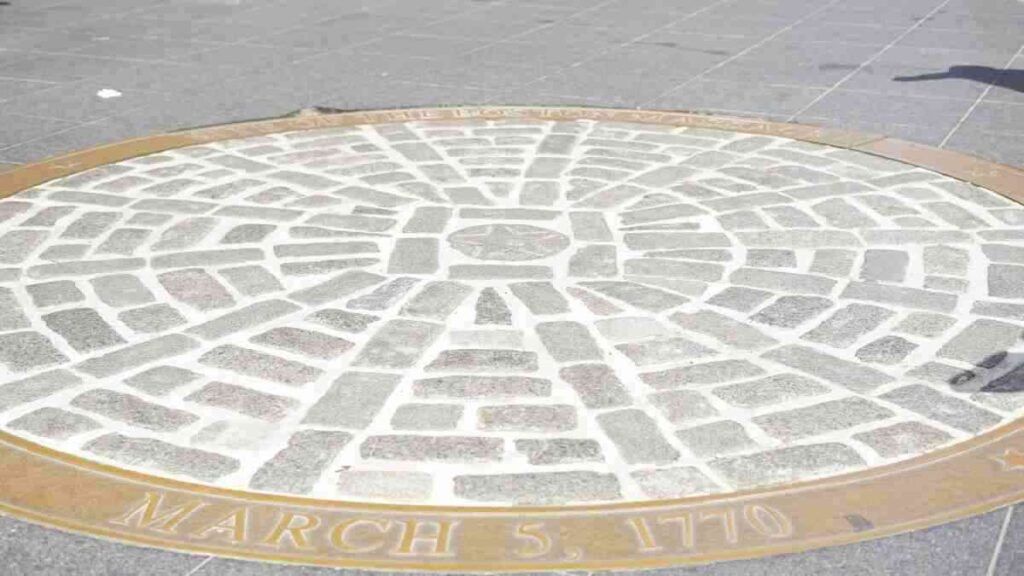
Battle Sites Discovery Guide Along Historic Boston
Military confrontation became inevitable when peaceful protest failed to resolve colonial grievances. Bunker Hill represents the transition from political resistance to armed revolution. Colonists proved they could fight professional soldiers successfully. Therefore, this battlefield demonstrated American determination to secure independence regardless of cost.
Freedom Trail Boston Stops at Bunker Hill
The Bunker Hill Monument honors the first big battle of the American Revolution. Colonial militia inflicted heavy casualties on British regulars here. Though technically a British victory, the battle proved American forces could fight. In contrast, the famous order “Don’t fire until you see the whites of their eyes” shows smart battle planning.
Climbing the 294 steps to the monument’s summit provides panoramic views. Boston and Boston Harbour help visitors understand the battle’s strategic significance. British forces controlled the city during the revolutionary period. However, American positions on surrounding hills threatened their security throughout the conflict.
The nearby museum shows items and displays that make this important battle feel real. Personal accounts and historical analysis help visitors understand 18th-century warfare complexity. Interactive displays honor the bravery of regular people who became great soldiers. Meanwhile, educational programmes connect past sacrifice with present freedom for future generations.
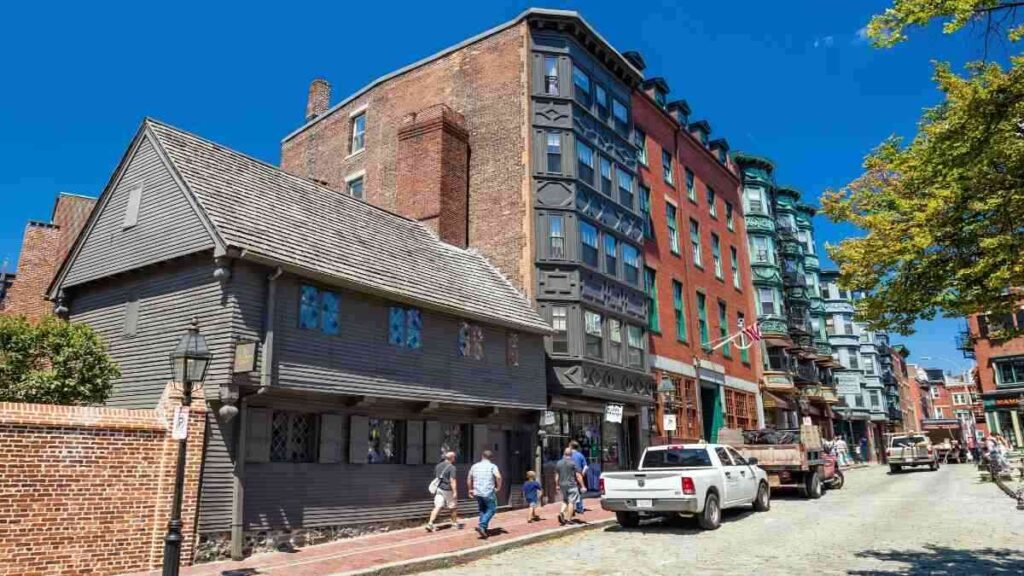
Freedom Trail Boston Stops: Heroes and Patriots
Individual courage made collective resistance possible as ordinary colonists chose to risk everything. Paul Revere’s midnight ride represents personal sacrifice that warned communities. These heroic actions by common citizens demonstrate democratic principles. Since then, democracy depends on individual responsibility rather than passive reliance on government protection.
Paul Revere’s Historic Home
The Paul Revere House stands as Boston’s oldest remaining structure today. It’s preserved exactly as it appeared when the famous silversmith lived there. Built around 1680, this modest dwelling housed a craftsman who became revolutionary hero. Although modest, the building’s small rooms and simple furnishings reflect middle-class colonial life.
Revere’s silver-making shop was on the ground floor where he made beautiful objects. He participated in revolutionary politics whilst maintaining his craft. His craft skills gave him money freedom that let him join political fights. Such as this, craftsmen like Revere could afford to challenge British authority through economic freedom.
Period furnishings and family artifacts create an intimate portrait of domestic life. Political commitment affected every aspect of daily existence during revolutionary times. Women and children shared the risks of men’s political activities. That is, entire families participated in the struggle for independence through personal sacrifice.
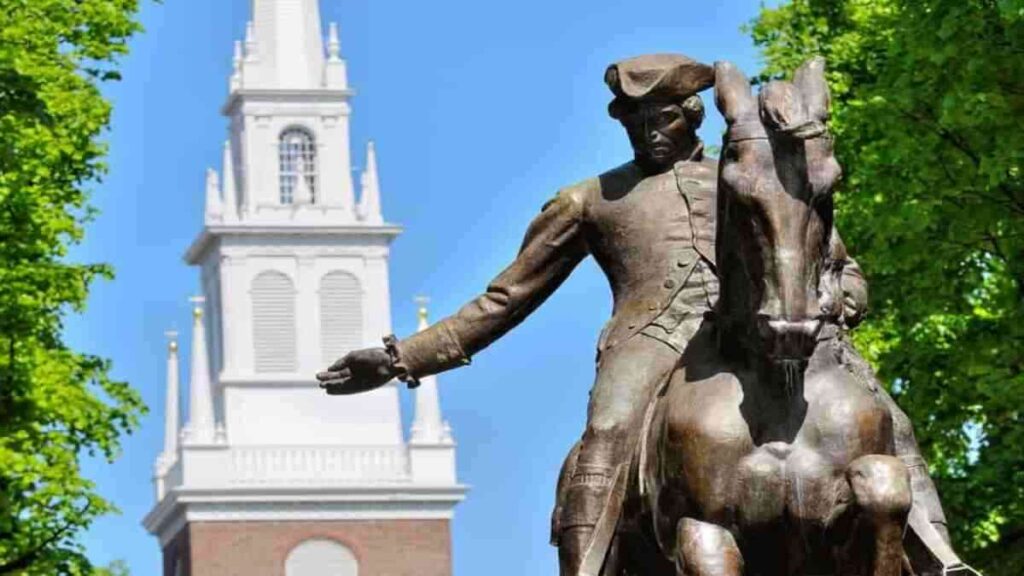
Freedom Trail Boston Stops: Historic Homes and Legacies
Domestic spaces reveal the human cost of revolution as families endured hardship. These preserved homes demonstrate that revolutionary commitment required daily courage. Women managed businesses and farms whilst men attended political meetings. In other words, these sites show that revolution affected entire households, not just famous leaders.
Freedom Trail Boston Stops: Patriot Residences
The Nichols House Museum on Beacon Hill represents upper-class colonial life. It produced many revolutionary leaders who had wealth and social position. These families chose principle over profit when supporting independence. To show, their sacrifice disproves claims that only poor colonists supported revolution.
Federal architecture reflects the optimism and prosperity that followed successful revolution. Americans built homes expressing their new national identity. These elegant structures demonstrate how political independence enabled cultural development. For example, the art and building styles created here changed how other buildings were designed.
Guided tours reveal daily life details that bring revolutionary history to human scale. Personal stories and family traditions help visitors understand historical events. These intimate glimpses show that events emerged from individual decisions. In order to, preserved interiors create emotional connections with past generations who secured our freedoms.
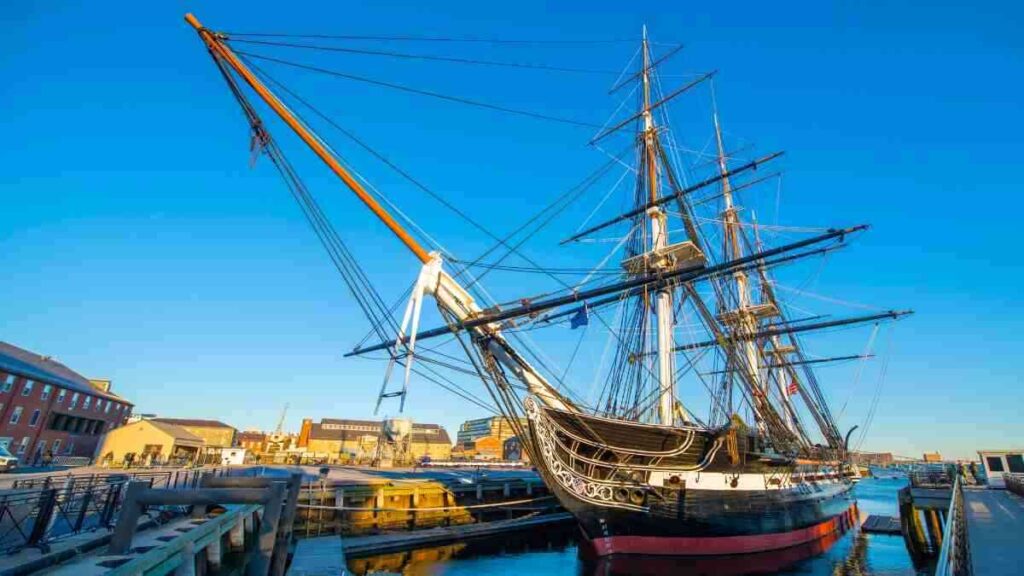
Freedom Trail Boston Stops: Maritime Heritage
Naval history intertwines with revolutionary events as Boston Harbour served as the stage. Events triggered armed conflict between Britain and her American colonies. The USS Constitution, called “Old Ironsides,” represents the traditional power of the American navy. Overall, this warship demonstrates how maritime strength enabled political independence through commerce protection.
Shipbuilding trades provided employment for thousands of colonial craftsmen. Their skills proved essential for both military and commercial success. The Charlestown Navy Yard showcases the industrial capacity that transformed America. Soon, these facilities created the economic foundation that supported political independence through innovation.
Modern preservation efforts maintain these maritime heritage sites as educational resources. They connect past achievements with present challenges for visitors. Interactive displays demonstrate how naval technology evolved over time. At last, the continuing mission of the USS Constitution reminds visitors that freedom requires vigilance.
Boston’s maritime heritage extends beyond military history to include commercial enterprises. They connected American markets with global trade networks successfully. The prosperity generated by international commerce provided resources that funded revolutionary activities. First, these historic sites demonstrate how economic and political freedom reinforced each other.
I recommend spending at least four hours exploring all the stops on the freedom trail. This trail route covers approximately 2.5 miles of historic walking. The trail makes a perfect leisurely day.

